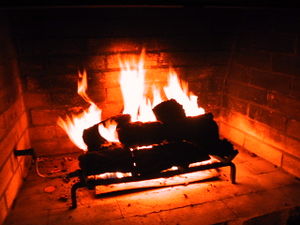
In colder climates throughout the world, the fireplace or hearth has traditionally been the central feature of the household, as it gives warmth to aid survival through an extended winter. The sensation of direct heat, and the mesmerizing leaps and flickers of a wood fire, make its use enjoyable in cold conditions even today.
As a result, people then and now gather around a fireplace for conversation, planning, or celebration in a more intimate fashion. After the workday, it is often the place a family meets at night before retiring to sleep. One famous use of this tradition in the United States during the Great Depression was President Franklin Delano Roosevelt's "fireside chats", weekly radio addresses in which he made use of the family gathering time to state his views on issues of national importance.
In many places, coal, wood or peat burning fires are being replaced by cleaner, safer and often cheaper natural gas and electric fires. Gas fireplaces very often burn off a small amount of their fuel in a flickering display meant to recall that of a wood fire. Alternatively, flame-shaped paper streamers wave vertically in the air, held up by the updraft produced by a heating element.
Many lower priced new homes are not equipped with a fireplace at all, its heating function long since taken over by central heating and its social function by the home entertainment center. Some fireplaces have been closed off not allowing them to be used, either the top of the chimney has a concrete slab installed over it or the bottom has had a board nailed to it. This is so the fireplace doesn't suck out warm air. Prefab fireplaces have become popular because of their lower construction cost but offer a limited range of sizes and styles. Brick or stone fireplaces have greater durablity and can be designed to meet exact specifications for opening size, depth, and facing material. They also cost a lot more to build.
A fireplace consists of foundation, hearth, firebox, facing, ashdump door, cleanout door, lintel, lintel bar, breast, damper, smoke chamber, throat, flue, chimney chase, crown, cap or shroud, and spark arrestor.
Types of fireplace include:
Manufactured or 'Prefab' fireplace with sheet metal fire box and double or triple walled metal pipe running up inside a wood framed chase with a chase cover and cap/spark arrestor at the top to keep the birds out and the sparks in. Within a hundred yards or so of salt water this type of chimney tends to rust out. Otherwise it's a good alternative to the more costly masonry chimney.
Masonry (brick or stone fireplaces and chimneys) with or without tile lined flue. Tiles are used to line the flue to keep the corrosive combustion products from eating away that the chimney flue lining. Unreinforced masonry chimney do not stand up to earthquakes well.
Reinforced Concrete Chimneys: Popular during the 1970s to 1980s. Fundamental flaws (the difference in thermal expansion rates between steel rebar and concrete which caused the chimney flues to crack when heated) bankrupted the US manufacturers and obsoleted the technique. This type of chimney often shows vertical cracks on the exterior of the chimney which worsen as the internal rebar rusts.
No comments:
Post a Comment